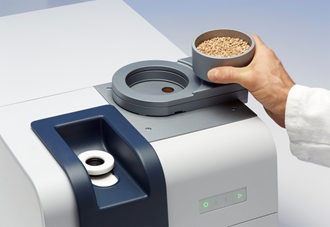There are endless questions and concerns when it comes to the quality of food, and the need for user-friendly tools to track and guarantee the integrity of foodstuffs is increasing across the world.
FT-NIR is an effective and robust technology developed to analyze raw materials, intermediates, and end products. The following are common tasks performed in food processing:
- Identification of raw materials
- Composition analysis
- Conformity testing
- Process monitoring
Principle and Advantages of FT-NIR Spectroscopy
NIR is an abbreviation of near-infrared spectroscopy. The electromagnetic spectrum spans between 800 and 2500 nm and borders to the red region of visible light. When a sample is irradiated with NIR light, the absorbs the light and the matching molecular vibrations are activated. The outcome is a NIR spectrum containing absorption bands of varying molecular groups (predominantly N-H, C-H, and O-H bonds) at typical wavelengths.
FT-NIR can be used to measure many samples quickly (standard measurement time for each sample is about 15 to 30 seconds). Since reagents are not needed, the running costs are kept to a minimum. Moreover, there is no need to pretreat the samples, which prevents common sources of errors and saves a lot of work.
The samples can be easily measured in disposable vials in the sample compartment or in petri dishes on the integration sphere. Inline measurements through optical fibers can also track many measuring points successively with a single spectrometer using optical multiplexers.
Many parameters can be simultaneously analyzed from the high information content of the spectra. In the food industry, the most crucial parameters, like fat, protein, lactose, dry matter/moisture, and even the ash content found in milk powder, are examined with a single measurement.
During a transmission measurement, the sample (for example, edible oils or milk) is irradiated, i.e. the amount of the transmitted radiation is measured by the detector. The proportion that is reflected by a semi-solid or solid sample (for example, meat or cheese) is detected during a reflection measurement. The type of sample (liquid, solid, and semi-solid), its homogeneity, and optical properties govern the choice of the measuring module.
Contemporary NIR systems include different software-controlled measuring modules to examine the various kinds of samples using only a single device.
FT-NIR spectroscopy offers the following major benefits:
- Easy sample presentation and handling
- No sample preparation, eliminating waste
- Allows multiple-component analysis within a minute
- Prevents standard operator errors associated with traditional analytical processes
- Can be used for liquid, solid, and semi-solid samples
Milk and Dairy Products
Milk, the starting point of any dairy product, is one of the best-regulated food products globally. Raw milk composition varies by region, season, and even from one cow to another, making the standardization step essential to preserve the consistent milk quality during the processing steps.
Several options are offered by modern FT-NIR spectrometers for an easy and rapid monitoring of raw milk, intermediate products, and finished products. For instance, the latest MPA II from Bruker in combination with the Liquid Sampling Module (LSM) examines all types of dairy samples (such as pasty, liquid, and solid) using only a single system (Figure 1).

Figure 1. Analysis of milk and liquid milk products with the FT-NIR spectrometer MPA II in combination with the liquid sample module LSM. Image Credit: Bruker Optics
Consequently, all process steps and their products, for example, milk, whey, yogurt, cheese, butter, ice cream, and protein powder, can be seamlessly controlled. An analysis like this can also be moved from the laboratory phase to the process phase.
An example of this is the direct analysis of whey protein powders and milk in the drying process. This not only optimizes the consistency of a product but also helps to save energy and relieves the strain placed on the test laboratory.
Flour and Cereals
For a majority of the people across the world, grain products form the basis of their everyday diet. The flour and milling sector has a crucial role to play in processing grain products into flour for a variety of baked goods.
Due to the requirements for flour and wheat quality (for example, DIN 10355), special and time-intensive test procedures are often needed to ascertain the behavior of the flour during processing. This intensive control is the only method to assure the right flour quality and the highest yield.
For millers, it is important to know the moisture content so that they can modify the wheat to a standard level prior to the milling process. For the flour producer, the protein content is a crucial factor as it influences the numerous processing properties, like gluten quality or water intake. The ash content present in the wheat acts as a guideline for the anticipated yield at the time of the milling process.
Several physical/chemical and rheological tests are often applied to the finished flour to make sure that the wheat flour is appropriate for baking, or whether adjustments need to be made to the manufacturing process.
Such parameters can be checked quickly using FT-NIR spectroscopy, leading to process optimization and considerable cost-savings. For this purpose, the sample is easily transferred to a sample cup with a quartz glass base and quantified in diffuse reflection (Figure 2). The speed of the FT-NIR analysis ensures a high sample throughput.

Figure 2. Measurement of wheat on the integration sphere of the MPA II. Image Credit: Bruker Optics
Meat and Sausages
The constant analysis of fresh meat and other ingredients in the meat sector is essential to adapt recipes to ensure a steady batch-to-batch quality of salami, sausages, and many different types of meat products.
Meat can be a highly complex raw material where even a slight variation in external impacts, such as animal nutrition, can cause a wide variation in the quality of the end meat product. Fat content fluctuations in the supplied meat can become a major issue for sausage producers if they are not aware of it. Most often, quantifying the fat content in raw meat is also a factor in the suppliers’ value-based payment.
FT-NIR spectroscopy serves as a useful tool for assessing the incoming raw materials. Parameters like moisture, protein, and fat can be concurrently established using just a single measurement. Once the results are available, decisions concerning the additional production process can be reached. This is also applicable to sausage products, in which the water activity (aW value) and salt content can be examined to improve the durability of products.
Edible Oils and Fats
Edible oils and fats contribute considerably to the regulation of different body functions; therefore, they are regarded as essential nutrients in people’s daily diet. The quality of edible oils and fats is evaluated using Iodine Value, fatty acid composition, Anisidine Value (AnV), Trans Fatty Acids (TFA), Free Fatty Acids (FFA), and various other parameters.
Standardized physical and chemical processes are often used to perform conventional analyses, like GC analysis, which not only consume time but also involve high operating costs. Moreover, such analyses usually need hazardous reagents and solvents that can lead to increased disposal costs and health risks.
The NIR analysis however does not require sample preparation, making it safe, fast, and cost-effective even for untrained personnel. The oil is simply filled into an 8 mm diameter glass vial and quantified in the sample compartment of the spectrometer (Figure 3).

Figure 3. The glass vial filled with oil is placed in the sample compartment of the spectrometer. Image Credit: Bruker Optics
For olive oils, an accurate analysis is specifically significant because an FFA value of below 0.8% is the main condition for categorizing the olive oil as “extra virgin.” The Pyropheophytin content and the proportion of 1,2-diacylglycerols in the oil specify whether the olive oil has been stored for an extended period of time or even stretched with refined oils to realize a lower acidity.
There are other applications that also involve the analysis of deep-frying oils to track the deterioration of the quality of oils, and the analysis of fish oils for the oxidation status and the individual omega-3 levels (Peroxide Value and Anisidine Value).
Other Uses
The animal feed sector is another major application area for near-infrared spectroscopy. Here, NIR spectroscopy provides various solutions for quality control, right from raw materials to finished feed.
The NIR technology can also be used for screening the health and nutrition claims on food labels. The analysis, which is usually performed in less than a minute, is employed to decide whether the product is right or not and must be tested using the standardized techniques for approval.
FT-NIR spectroscopy can identify impurities or adulteration in the area of food safety. This can be attributed to the high information content of NIR spectra that enables the fingerprint of the whole sample to be created. A non-specific check within the detection limits can be achieved by comparing the delivered raw materials with those of known quality.
Production Control
Furthermore, the production process involves several quality assurance requirements that must make sure that systems work optimally and that only a minimal scrap is generated. Here, users can:
- Improve and reduce the drying processes by quickly determining the residual moisture
- Find out the control doses and mixing quality during the production of mixtures
- Analyze the product parameters online to respond as fast as possible if the specifications are at risk
For instance, during the production of butter, it is desirable for economic reasons to keep the water content of butter as close as possible to the agreed maximum limit of 16%, because water is considerably cheaper when compared to milk fat. To track the moisture content of the butter with NIR, a reflection probe is installed in the butter stream via a flange.
The excellent accuracy of the measuring technique enables the plant operator to establish the water content down to around 0.1%.
With a correspondingly high throughput, even tenths of a percent make a noticeable saving throughout the year, meaning an investment made in inline technology is worth considering.
With flow cells and transmission probes, liquid products like beverages, edible oils, or milk can also be quantified inline. In this way, tanks, pump lines, or other parts of the system can be tracked, which rapidly pays off with high throughputs.
Conclusion
Contrary to a majority of wet chemical processes and other reference techniques like HPLC or GC, FT-NIR technology is safe, fast, and economical because no gases, solvents, or chemicals are used. FT-NIR is the first choice for analyzing numerous organic components and is perfect for an array of food products.
As a robust tool, FT-NIR spectroscopy should play an integral role in the food sector. The reliable and rapid analysis results that are obtained help to optimally monitor the production processes, raw materials, and end products. FT-NIR spectroscopy is the tool of the future and is already substituting several of the slower, especially wet chemical analysis methods.

This information has been sourced, reviewed and adapted from materials provided by Bruker Optics.
For more information on this source, please visit Bruker Optics.